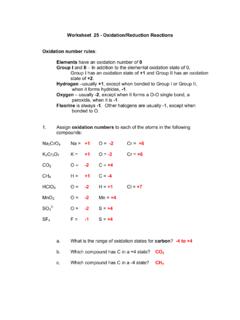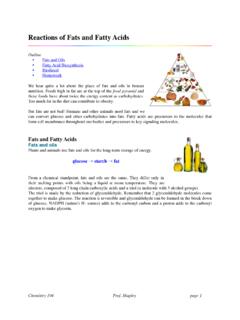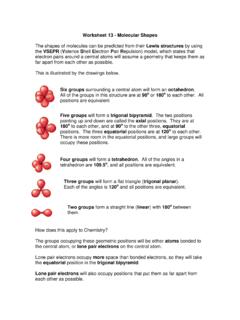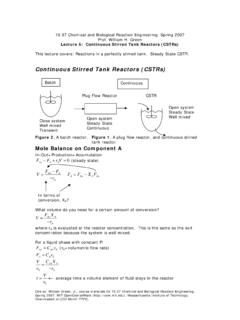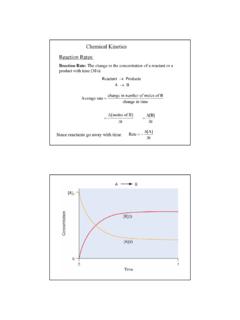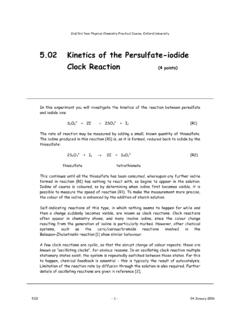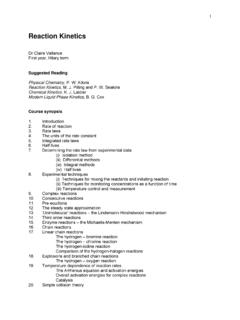Transcription of Oxidation Reactions of Sugars - University Of Illinois
1 Oxidation Reactions of SugarsThe Oxidation of Sugars provides energy in cellular respiration. Sugars are also the precursors to the other organic molecules in organisms. Stepwise Oxidation of an alcohol function group in a sugar produces an aldehyde or ketone. An aldehyde can be oxidized to a carboxylic acid group. Outline Oxidation and Oxidation State Oxidation of Alcohols and Aldehydes Oxidation of Sugars HomeworkWatch the video on the reaction between sugar (in a gummy worm) and a strong oxidizing agent, KClO3. All the carbons in the sugar are oxidized to carbon dioxide and a great deal of energy is States in sugar ReactionsOxidation StatesA previous lecture discussed how you could determine the Oxidation state of any atom in a molecule from the Lewis structure.
2 Whenever the Oxidation numbers of some atoms change from reactants to products, it is important that the electrons that are lost by any atoms exactly equals the number that are gained by other 's look at the Oxidation states of the atoms in glucose. We get the Oxidation states by (1) drawing the Lewis structure, (2) breaking all bonds and giving the electrons in the bond to the more electronegative element, and (3) comparing the number of electrons around each element to that element's number of valence electrons.
3 Oxidation states are always given in Roman numerals to distinguish them from formal charges. We can see that the Oxidation state of all oxygen atoms is -II and the Oxidation state of all hydrogen atoms is I. The oxidations states of the carbon atoms varies between I and -I with an average Oxidation state of we'll look at the oxidations states for some other molecules. Half Reactions for Oxygen + GlucoseFirst let's consider the combustion of sugar (or respiration). Glucose reacts with molecular oxygen to produce carbon dioxide and water.
4 The carbon atoms in glucose are oxidized. That is, they lose electron and go to a higher Oxidation oxygen atoms in molecular oxygen are reduced. That is, they add electrons and go to a lower Oxidation we want to represent only the Oxidation process in an equation, we show only the reactant that becomes oxidized. We can use H2O or H+ to balance oxygen and hydrogen atoms on either side of the equation. Each of the carbon atoms, on average, is oxidized by 4 electron for a total of 24 electrons. To balance the Oxidation half reaction, we need to add 6 water molecules to add enough oxygen atoms to make all of the carbon dioxide molecules.
5 There will also be 24 protons as consider the reduction of molecular oxygen (0 Oxidation state) to water (-II) oxidiation state. Each oxygen atom requires 2 electrons, for a total of 4. To balance the reaction, we can add 4 protons to the reactant side of the get the net reaction, we multiply one of the equations by some factor so that the electrons produced equals the electrons Reactions for Chlorate + GlucoseChlorate anion is another oxidizing agent (see the gummy worm reaction on the index page) that can oxidize glucose and become reduced.
6 The Oxidation of glucose to carbon dioxide is the same as Cl(V) in the chlorate ion is reduced to Cl(-I) in the chloride anion for a reduction of 6 electrons. Multiplying the reduction half reaction by 4, to use 24 electrons, and combining the Oxidation and reduction half Reactions gives us the net reaction. Half Reactions for Hydrogen + GlucoseIn the reaction with hydrogen, hexane and water are produced. Let's look at the Lewis structure and Oxidation states of the atoms in going from glucose to hexane, the carbon atoms are reduced by a total of 14 electrons.
7 Hydrogen is oxidized from Oxidation state 0 in H2 to Oxidation state I in is necessary to multiply the Oxidation half reaction by 7 to have equal numbers of electrons in the two half Reactions of SugarsOxidation of Alcohol GroupsAlcohols are organic molecules with the C-OH functional group and Sugars always have many of these groups. Oxidizing agents, such as chromium trioxide, convert the C-OH group of alcohols into the C=O group of an aldehyde or a ketone. In an aldehyde, the carbonyl carbon is bonded to one other carbon atom and one hydrogen atom.
8 In ketones, the carbonyl carbon is bonded to two other carbon atoms. Let's look at the possible changes in Oxidation state in the reaction of one of these alcohols and chromium trioxide. Only the carbon of the alcohol functional group and the chromium center change Oxidation states. We can write the Oxidation reaction of ethanol to ethanal in half Reactions . The carbon of the alcohol is oxidized by 2 electrons, from -I to I, and the chromium atom is reduced by 3 electrons, from Cr(VI) to Cr(III). Because the number of electrons transferred must be equal, we multiply the Oxidation half reaction by 3 and the reduction half reaction by 2 before we add them to get the net Oxidation -reduction oxidizing agents (easily reduced compounds) can oxidize alcohols.
9 This includes other chromium(VI) compounds, like K2Cr2O7 and Kr2 CrO4. Oxidation of Aldehyde GroupsAldehydes are much easier to oxidize than ketones. The oxidizing agents Ag+, Cu+2, and K2 CrO4 can transform an aldehyde to a carboxylic carbonyl carbon is oxidized by 2 electrons from the I to the III Oxidation state. Silver metal is produced when Ag+ combines with 1 half Reactions for the Oxidation of ethanal to ethanoic acid by silver(I) are organic compoundsTo find the standard name of any simple alcohol, aldehyde, ketone, or carboxylic acid it is necessary to find the name of the longest carbon chain that contains that functional group.
10 The standard ending for any saturate hydrocarbon is "ane". Replace the final e with "ol" for an alcohol, "al" for an aldehyde, or "oic acid" for a carboxylic acid. Number the carbon atoms (with the functional group at the lower number end of the chain) to indicate the position of the functional group for alcohols or for ketones. The aldehyde and carboxylic acid functional groups are always on C1 and don't need to be numbered. Partial Oxidation Reactions of SugarsReducing SugarsAldehydes are particularly easy to oxidize.
